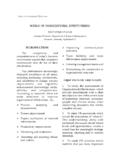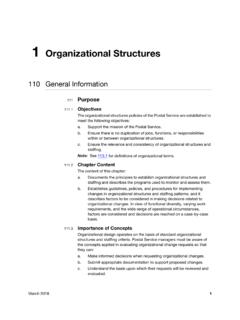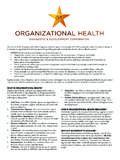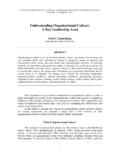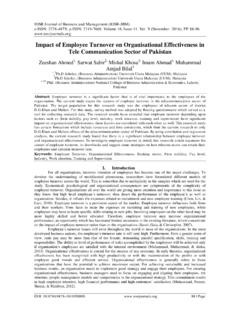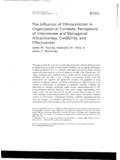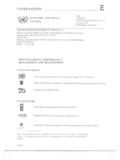Transcription of Pushing up to a point: Assertiveness and effectiveness in ...
1 Author's personal copy Available online at Research in Organizational Behavior 29 (2009) 111 133. Pushing up to a point: Assertiveness and effectiveness in leadership and interpersonal dynamics Daniel Ames *. columbia Business School, columbia university , USA. Available online 3 August 2009. Abstract Past work on interpersonal Assertiveness and organizational effectiveness paints a mixed picture: some research suggests a positive link, other work highlights negative effects. This article reviews recent research and an account that stems from a different perspective, looking at Assertiveness as a factor in leadership shortcomings and failure. This approach suggests that interpersonal Assertiveness is a major factor and has a curvilinear, inverted-U-shaped relationship with leadership effectiveness .
2 I review evidence for this effect as well as social and instrumental outcome mediators. I consider moderators and boundaries, sources of individual differences in assertive behavior, prospects for changing Assertiveness , and factors in the perception of assertive behavior. Beyond the specific results I review, I argue that this program of work offers value by highlighting the lens of conflict as a generative perspective on leadership . Exploring how, and how hard, leaders fight pulls in insights from a variety of literatures and prompts new research that can help expand the scholarly portrait of leadership . # 2009 Elsevier Ltd. All rights reserved. Contents 1. Introduction .. 112. 2. interpersonal Assertiveness .. 112. 3. The prevalent challenge of Assertiveness .. 113. 4. Curvilinear effects, mediators, and situational fit.
3 116. Curvilinear effects .. 116. Mediators .. 116. Situational fit .. 117. 5. Assertiveness research in context .. 118. Past work on related constructs .. 118. Habits of past research .. 119. Questions of leadership .. 120. 6. Sources of Assertiveness : why so many get it so wrong .. 121. 7. Assertiveness expectancies .. 122. Where do expectancies come from? .. 123. Prospects for change .. 125. 8. The perception and impact of Assertiveness .. 125. 9. Rationales and account-giving .. 126. * Tel.: +1 212 854 0784; fax: +1 212 316 9355. E-mail address: 0191-3085/$ see front matter # 2009 Elsevier Ltd. All rights reserved. Author's personal copy 112 D. Ames / Research in Organizational Behavior 29 (2009) 111 133. 10. Future directions and conclusions .. 129. Mediating and moderating factors.
4 129. Beyond direct conflict .. 129. Concluding thoughts .. 129. References .. 130. 1. Introduction From Buddha's middle way to Goldilocks' porridge, cultural wisdom reflects the fact that some things are best in moderation. So it is, perhaps, with interpersonal Assertiveness . Be not too sweet, lest people swallow you up ..'' an old proverb cautions, yet not too bitter lest they spit you out.'' Leaders, subordinates, and colleagues vary in their Assertiveness and, accordingly, most of us can think of yielding and passive coworkers who have been swallowed up as well as bullies and jerks who have been spit out. Yet anecdotes and proverbs go only so far in revealing the mechanics of leadership and interpersonal relations. What does social science have to say about the link between Assertiveness and organizational effectiveness ?
5 Does it matter much how hard leaders push? Why do individuals display different levels of Assertiveness and what are their prospects for changing? What governs how assertive behavior is perceived? In various forms, these matters have interested scholars for generations, yet new answers to these questions have taken shape in recent research ( , Ames, 2008a). This article attempts to summarize a number of recent findings, put them in context, and extend the overarching story of Assertiveness . In the end, I believe the account of Assertiveness I present here enhances our understanding of management and leadership , challenges some past habits of organizational and behavioral research, and points toward potential interventions that can help individuals assert themselves in effective ways, for their own sake as well as for the people and organizations around them.
6 It is worth stressing at the outset that the conception of Assertiveness at the heart of this account comes not so much from prior scholarly theories but from everyday perceptions people have of one another as managers and leaders in action and, especially, in conflict situations. As such, this chapter unfolds in a somewhat unorthodox way. I begin by fleshing out the everyday conception of Assertiveness and continue by reviewing the basic account and empirical evidence for how it relates to leadership . With this established, I then put these ideas in the context of historical work. This review shows how elements of the account I offer were anticipated by past work and yet it also identifies reasons why the story of Assertiveness and leadership may have been incompletely understood or mischaracterized previously.
7 After reviewing past work, I press further up and down the causal chain, presenting arguments and findings on the sources of interpersonal Assertiveness as well as how others perceive and react to it. I conclude by considering unanswered questions and future research directions. 2. interpersonal Assertiveness As I use the term here, Assertiveness is a characterization of how a person responds in a situation in which her positions and/or interests are, or could be, in conflict with others' positions or interests. That is, given some real or potential opposition, people must repeatedly grapple with a basic question: How hard should I push? I. believe peoples' behavioral responses to this question are generally arrayed in the minds of both actors and observers along a dimension ranging from avoidance and passivity at one extreme to aggression and hostility at the other.
8 Some concrete organizational examples help to illustrate Assertiveness as it is approached in this article. Imagine that a newly formed team of coworkers gathers to discuss their organization's strategy. In the first meeting, one member advocates entering a new geographic market, but another has recently analyzed the possibility and concluded with confidence that it would be a disastrous move. Does the skeptical member speak up forcefully in this new group, unequivocally disparaging the option, and championing her own ideas? Does she make a more diplomatic observation about the need for caution and analysis? Or does she hold back entirely, wishing to avoid confrontation and hoping that the truth will eventually emerge? Imagine that the head of a marketing group discusses his unit's annual budget with the organization's CEO.
9 On the line are his resources for buying advertising as well as funding his own people, including bonuses and new hires. Author's personal copy D. Ames / Research in Organizational Behavior 29 (2009) 111 133 113. The CEO opens by giving the marketing group an ambitious market share goal and a paltry budget increase. Does the group's leader show resistance and push for additional resources, politely probe for areas of potential adjustment, or accept the goal and budget as given? Lastly, consider a manager preparing to give a subordinate his annual face-to-face review. She is pleased with his work in some areas, but finds other parts of his performance appalling. Does she focus the conversation on a blunt and unflinching dissection of his problems and their costliness? Does she applaud his strengths, describe his shortcomings, and offer her support?
10 Or does she avoid problem areas altogether, keeping the conversation short and positive? These cases highlight the kinds of daily choices individuals and managers make in their interpersonal Assertiveness toward peers, superiors, and subordinates. For this article, I define Assertiveness as a dimension in everyday perceptions reflecting an individual's interpersonal willingness to stand up and speak out for their own interests and ideas, pursuing their objectives and resisting others' impositions. This spectrum is meant to reflect the folk construct that I believe is present in everyday judgments of interpersonal behavior, based on my experience in coaching professionals and executives and in my research on perceptions of the strengths and weaknesses of organizational managers and leaders (cf Ames & Flynn, 2007).










